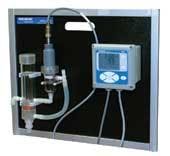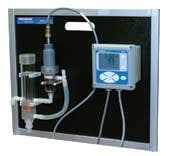The question of how best to measure free chlorine in drinking water has been an issue for some years. Use a reagent-based method? Or, use a reagent-free method and deal with pH dependence? Recent developments have introduced a third alternative: a monitoring system that needs neither reagents nor a correction for pH dependence.
Most water plants are required by the EPA to continuously monitor free chlorine in the product water. Two types of measurements have been used for years: colorimetric and amperometric. The colorimetric method requires reagents, and the amperometric method, because it is pH dependent, requires either reagents to adjust pH or a correction using an external pH sensor.
The new Model FCLi free chlorine system recently introduced by Emerson Process Management, Rosemount Analytical, does not require sample conditioning systems or reagents to control pH. Nor does it require an auxiliary pH sensor for pH correction. Instead, the pH adjustment takes place inside the sensor, producing a signal that changes less than 4% per unit change in pH between pH 6.5 and 10. Below pH 6.5 the change is less than 1%. The linear range of the sensor is 0 to 20 ppm (mg/L).
The system uses a three-electrode, membrane-covered amperometric sensor. The sensor consists of a hydrophilic membrane stretched over a gold mesh cathode. A silver/silver chloride reference electrode and an external copper auxiliary electrode complete the circuit. The fill solution is saturated succinic acid slurry.
During operation, an electrochemical reaction, driven by the polarizing voltage, consumes free chlorine at the cathode surface. The auxiliary electrode provides the electrons for the cathode reaction, and a current proportional to the reaction rate flows between the electrodes. Because the concentration of chlorine at the cathode is zero, free chlorine in the sample continuously diffuses through the membrane and is destroyed at the cathode. As a result, the cathode current is proportional to the diffusion rate, which is proportional to the concentration of free chlorine in the sample.
All amperometric free chlorine sensors, including the FCLi, generate a raw current that depends primarily on the concentration of hypochlorous acid. Because the fraction of free chlorine present as hypochlorous acid is a function of pH, readings will be in error if the sample pH changes from the value it had during calibration.
To correct for pH changes, some manufacturers treat the sample with acid to convert hypochlorite to hypochlorous acid. Others continuously measure the pH and use the pH value to correct the chlorine sensor reading. With the Model FCLi, the sensor uses a highly buffered acidic fill solution for internal pH adjustment. The fill solution converts all the free chlorine entering the sensor as well as much of the free chlorine at the outside surface of the membrane into hypochlorous acid. Thus, the sensor response is practically independent of pH.
For customers who wish to measure pH, an option that includes a pH sensor and flow cell is available.
Maintenance is simple and consists of replacing the membrane and fill solution every few months. The process takes only a few minutes and requires no special tools or fixtures.
The Model FCLi includes the new Model 1056 analyzer with a large, high contrast display. The analyzer has two programmable 4-20 mA analog outputs and four programmable alarm relays. A security feature prevents unauthorized tampering with calibration and configuration settings. Built-in help screens assist in troubleshooting when fault and warning conditions occur.
Valves, rotameters and pressure regulators to control sample flow are not required. A constant head overflow sampler ensures the correct flow to the sensor no matter how much the sample flow or pressure changes. A check valve in the inlet prevents the sensor flow cells from going dry if sample flow is lost. The check valve opens at 3 psig.
To eliminate wiring issues, a quick disconnect Variopol cable is standard. The flow cell is constructed of clear plastic to allow users to inspect the sensor for fouling.




